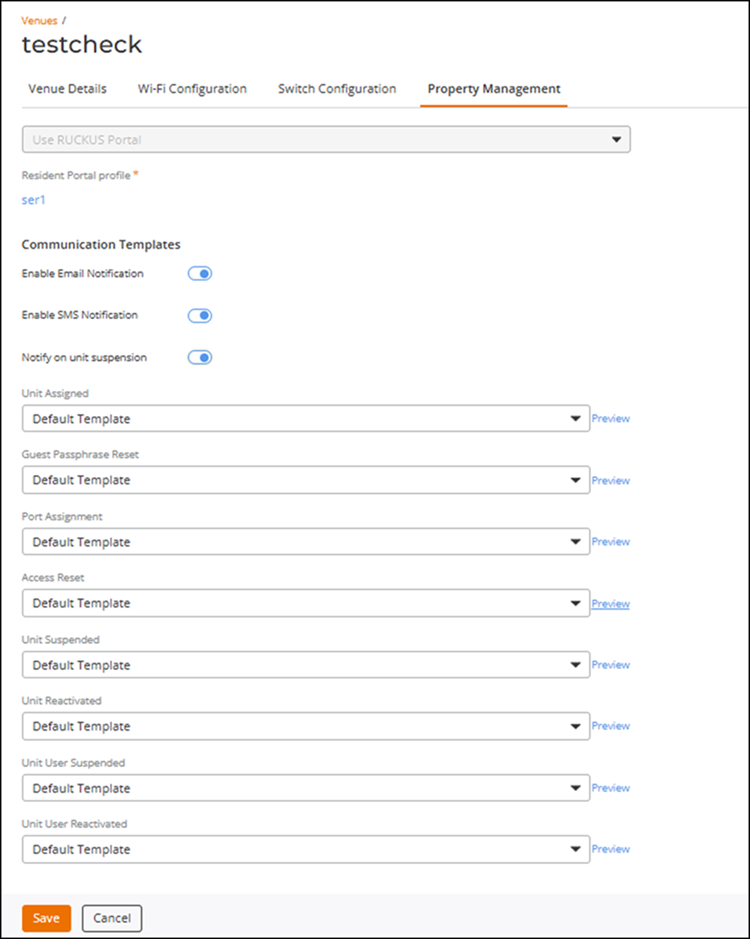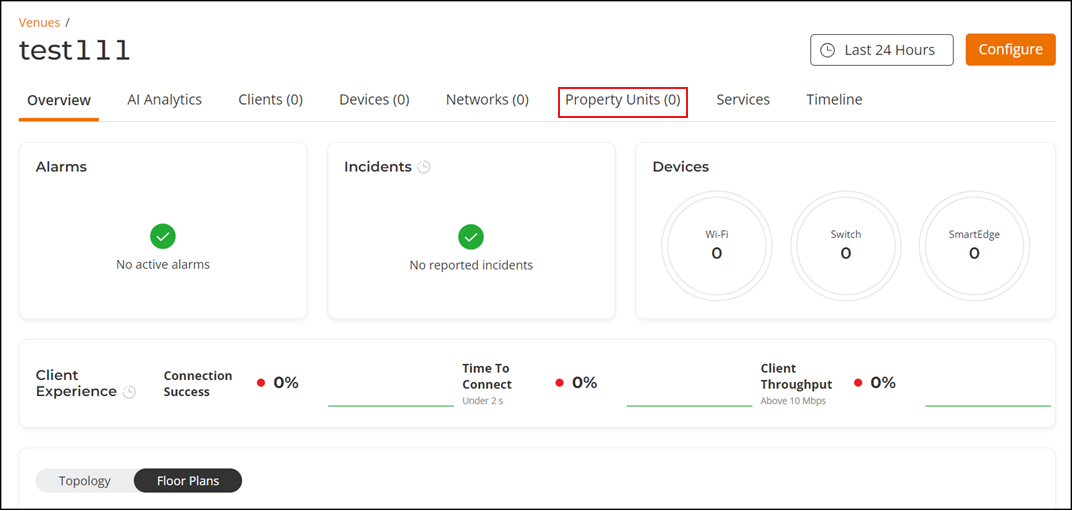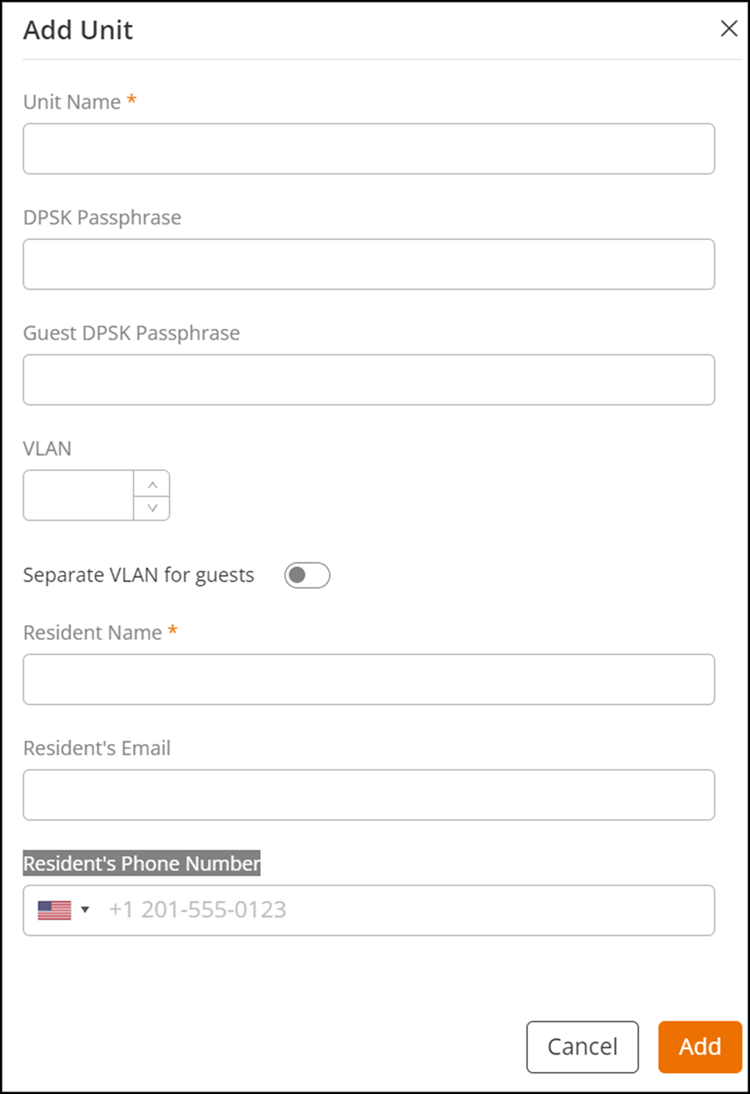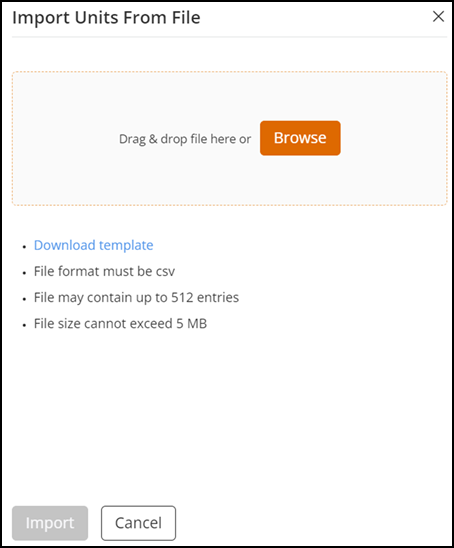Enabling and Configuring Property Management and Property Units
The Property Management feature streamlines network administration for multi-dwelling units (MDUs), hospitality environments, and other property-centric deployments, allowing you to manage network access and services at the unit or tenant level. It integrates with identity groups, onboarding workflows, and resident portals to provide a seamless experience for both administrators and end users.
The Property Management feature streamlines network administration
for multi-dwelling units (MDUs), hospitality environments, and other property-centric
deployments, allowing you to manage network access and services at the unit or tenant
level. It integrates with identity groups, onboarding workflows, and resident portals to
provide a seamless experience for both administrators and end users. Before enabling and
configuring the Property Management feature and adding Property Units, you must complete
the following tasks:
- Create a Venue (refer to Adding a Venue)
- Create an Identity Group( refer to Adding an Identity Group)
-
On the navigation bar, select
Venues.
The Venues page is displayed.
- Select the checkbox for Venue name and click Edit. Alternatively, click on the Venue name, then click Configure.
- Select the Property Management tab.
- Toggle on the Enable Property Management button to enable property management.
-
In the Identity
Group field, select the Identity Group from the list. Note that
the Identity Group cannot be changed once Property Management has been
enabled.
Note: Configure DPSK Service before selecting the Identity Group.
- Toggle on the Enable Guest DPSK for Units button if you want the units to have a Guest DPSK assigned to them.
-
In the Resident Portal field, select from the following
list:
- No Resident Portal: Select this option if you do not want to use the residence portal provided by RUCKUS One.
- Use RUCKUS Portal: Select this option if you want to develop your own custom portal using REST APIs. After you select this option, the Resident Portal profile field is displayed. In the Resident Portal profile field, select an existing Resident Portal profile from the list, or click Add Resident Portal to create a new Resident Portal profile. Refer to Creating a Resident Portal.
- Use Your Own Portal: Select this option if you want to use a portal. The option allows external systems to integrate seamlessly with RUCKUS One Property Management services through APIs. This feature is designed for tenants who prefer to utilize their existing portal infrastructure rather than adopting our provided portal solution. refer to the Resident Portal Login API documentation (https://docs.ruckus.cloud/api/consolidatedApi.html#tag/Resident-Portal-Login-API) and the Resident Portal Unit API documentation (https://docs.ruckus.cloud/api/consolidatedApi.html#tag/Resident-Portal-Unit-API)
-
In the Communication
Templates section, select the mode by which you would prefer to
receive the notifications from the venue during onboarding, passphrase reset,
port assignment, and access reset. You may select email, SMS, or both methods.
Toggle on the Enable
Email Notification button to enable email communication. Toggle
on the Enable SMS
Notification button to enable SMS communication. Toggle the
Notify on unit suspension button to enable suspension
notification.
By default, notifications are sent for events such as unit assigned, guest passphrase reset, port assignment, and access reset. When the the Notify on unit suspension option is enabled, notifications are sent for unit suspension, unit reactivation, unit user suspension, and unit user reactivation.
Communication Templates 
-
Select and preview the
communication templates. When you click Preview, a dialog
box appears displaying the template wording (which cannot be changed); click
Email or SMS to preview the
wording and layout for each communication method..
- Unit Assigned: Notifies users when a unit is assigned to them. If you have configured a resident portal then select the Default Template; if not, then select the Default Template - No Portal URL.
- Guest Passphrase Reset: Notifies the unit owners when their guest passphrase has been changed. By default, the Default Template is selected.
- Port Assignment: Notifies the unit owner when a network port is assigned to them. By default, the Default Template is selected.
- Access Reset: Notifies the unit owners when the access URL to their Resident Portal is changed. By default, the Default Template is selected.
- Unit Suspended: Notifies the unit owner when a unit is suspended. By default, the Default Template is selected.
- Unit Reactivated: Notifies the unit owner when a unit is reactivated. By default, the Default Template is selected.
- Unit User Suspended: Notifies the unit user when the user is suspended. By default, the Default Template is selected.
- Unit User Reactivated: Notifies the unit user when the user is reactivated. By default, the Default Template is selected.
- Click Save. Property Management is enabled and you can edit the Property Management fields until you add a Property Unit.
-
Click Back to Venue Details.
The Venue details page is displayed and you can see the Property Units tab displayed on this page.
Venue Details Page 
-
Select the Property
Units tab to add the units either manually or by importing from a
file.
The Property Units page is displayed.
Property Units Page 
-
Click Add Unit to add a
single unit manually.
The Add Unit sidebar is displayed.
Adding a Unit 
-
Complete the following fields:
- Unit Name: Add a unit name for the property units.
- DPSK Passphrase: (Optional) Enter a passphrase that you want users to provide before they can access the network. Within a DPSK pool, the passphrase length is set by the administrator. The passphrases must adhere to the administrator-configured setting, which can range from 8 through 63 characters. If left empty, a passphrase will be generated by the system. Refer to Adding a DPSK Service for more information.
- Guest DPSK Passphrase: Enter a passphrase that you want only guest users to provide before they can access the network. Within a DPSK pool, the passphrase length is set by the administrator. The passphrases must adhere to the administrator-configured setting, which can range from 8 through 63 characters.
- VLAN: (Optional) Enter a VLAN ID (ranging from 1 through 4094). This field appears only when the Enable Guest DPSK for Units option is enabled in the Property Management configuration.
- Separate VLAN for Guests: Toggle on the button to enable the guests VLAN and enter a VLAN ID (from 1 through 4094) for guests that does not match the VLAN configured above.
- Resident Name: Enter a resident name.
- Resident's Email: (Optional) Enter a resident email. To receive notifications over email, you must add an email address.
- Resident's Phone Number: (Optional) Enter a resident phone number. To receive notifications over SMS, you must add a phone number.
- Data Usage Metering: (Optional) Select an existing Data Usage Metering profile or Add a new one. The profile allows you to enable or disable rate limiting as well as data consumption control. The profile will be applied to all devices that belong to this unit.
-
(Optional) Click Import from
File.
You can import multiple units at once, however it is not mandatory to import units in bulk.The Import Units from File sidebar is displayed.
Import Units from File Sidebar 
-
Complete the following steps to import the unit.
A CSV format of the file is available for download.
- Drag and drop a .CSV file or click Browse to locate the .CSV file, and click Open to upload it.
- (Optional) Click Download template to download the template or use file latest import.
- Using a spreadsheet application, open the .CSV file.
-
Complete the following fields to identify the Unit:
- Unit Name: Add a unique unit name for each of the property units.
- DPSK Secret: Enter a passphrase that you want users to provide before they can access the network. Within a DPSK pool, the passphrase length is set by the administrator. The passphrases must adhere to the administrator-configured setting, which can range from 8 through 63 characters.
- Unit VLAN: Enter a VLAN ID (ranging from 1 through 4094).
- Guest DPSK Secret: Enter a passphrase that you want only guest users to provide before they can access the network. Within a DPSK pool, the passphrase length is set by the administrator. The passphrases must adhere to the administrator-configured setting, which can range from 8 through 63 characters.
- Guest VLAN: Enter a VLAN ID (from 1 through 4094) for guests that does not match the Unit VLAN ID.
- Resident Name: Enter a resident name.
- Email: Enter a resident email.
- Phone Number: Enter a resident phone number.
- Save the .CSV file.
-
Click
Import.
If the import is successful, the Import Units from File sidebar displays a message that units were imported successfully. If the import fails, the Import Units from Files sidebar displays an error message with details for each Unit that failed to import.
- If any Units failed to import, open the .CSV file. Fix the issue for each Unit that failed to import, remove the Units that were imported successfully and save and close the file. Import the .CSV file again.
-
Click Add.
The property units are added to the property.Note: Disabling Property Management for a venue after it has been enabled may cause clients to lose networking services.